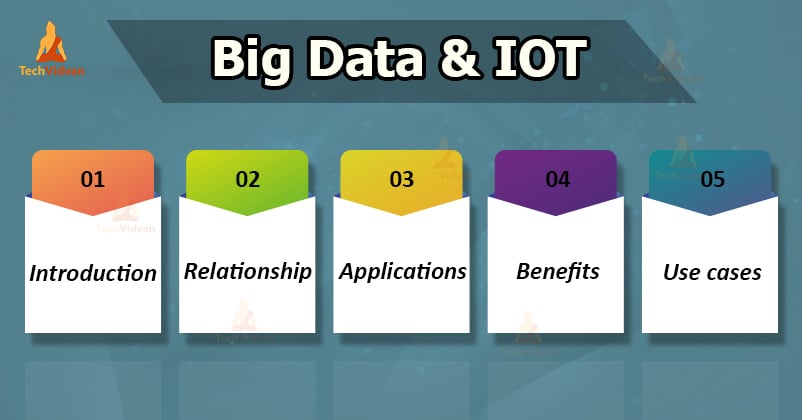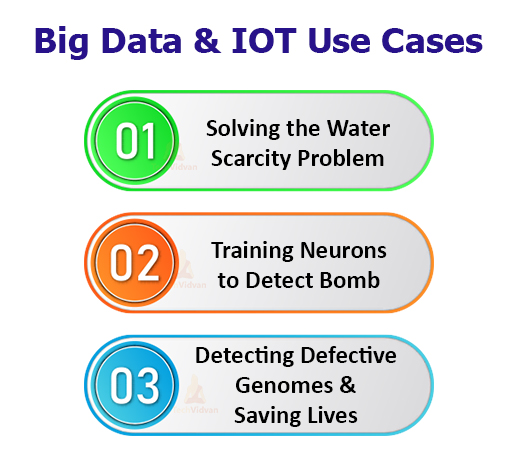Big Data and IOT – Taking care of World’s Biggest Aspirations
Big data will replace the need for 80% of all doctors” – By Vinod Khosla, C0-founder of Sun Microsystems
There is no denying the fact that the future of technology lies in the hands of data and its analysis. We are living in an age where with each passing day, more machines and devices are connect to the internet. They are continuously transmitting the information to the internet for analysis.
The main objective of this analysis is to harness this data to discover trends and results. These trends and results can help any business with a positive impact.
When we are talking about the data ruling the future, then the most buzzed words are the Big Data and IOT (Internet of Things). Both practices are closely related.
In this tutorial, firstly we will see what is Big data and IOT, their relationship and applications. In addition, we will also see their use cases.
What is Big Data and IoT?
In simple words, Big Data involves a large set of structured, unstructured or semi-structured data and analysis of that data to get insights into the business trends. Big Data has the potential to help companies to improve operations and make faster and more intelligent decisions.
Basically, the data is collected from a number of sources including emails, mobile devices, applications, databases, servers, and other means. This data when getting captured, formatted, manipulated and stored, helps to gain useful insight for companies and also helps to increase revenues.
Whereas, the Internet of Things (IoT) refers to a system of connected physical objects via the internet.
The term ‘thing’ in IoT can be a person or any device which is assigned through an IP address. A ‘thing’ collects and transfers data over the internet without any manual intervention with the help of embedded technology.
It helps them to make the interaction with the external environment or internal states to make the decisions.
Relationship between Big Data and the Internet of Things (IoT)
In the past few years, the use of big data analytics has grown tremendously. Business and services are frequently adopting big data analytics. And at the same time, the Internet of Things (IoT) has entered the market.
While separately the two trending technologies give plenty of excitement, combining the two only multiples the anticipation. We can consider big data and the IoT is going hand in hand. Organizations are grabbing hold of the data, and the IoT is acting as a major source of that data.
According to a study, it is a prediction that by the end of the year 2020, the Internet of Things will generate a stunning 4.4 trillion GB of data in the world. It makes sense considering that by 2020, there will be 10 billion devices and sensors which will connect to the internet.
All these devices will be gathering, analyzing, sharing, and transmitting data all in real-time. Without the data, IoT devices are simply not having the same functionality and capabilities. Therefore, “data is considered as the fuel that helps the Internet of Things run”.
Big data and IoT greatly impact each other. The more the Internet of Things grows, the more demands will be placed on businesses of Big data capabilities. Organizations already know that they want Big data and Iot, they simply have to find the right tools and resources to do so.
Since the IoT and Big data are closely related, there are plenty of examples of their application in organizations.
Applications of Big Data and IoT in different industries
1. The transportation industry has placed IoT sensors in their vehicles to track them. This not only helps companies to keep a close eye on where their vehicles are but it also gives them data about fuel efficiency, delivery routes, etc.
This information is very helpful in improving organizational productivity.
2. Manufacturing companies also use Big data and IOT. By installing IoT sensors with equipment, companies are able to collect vital operational data on their machines. This gives them a detailed look at the performance of machines and lets the companies know when machines need repair.
Repairing cost is usually low when we compare to replacing equipment. So investment in Big data and IoT saves the businesses money also.
3. Disney World’s MagicBand is another example of the IoT and Big data application. The band keeps track of hotel rooms, rooms, meals, etc.
What is the Impact of Big Data & IoT on each other ???
Big Data and IoT have a huge impact on each other. The more the IoT grows it more it will place the demand on businesses regarding Big Data capabilities.
Today the IoT generated data is increasing at a huge rate, and conventional data storage technology is already being pushed to its limits.
As a result, it demands more advanced and innovative storage solutions. These continuously growing demands and workloads result in updating the infrastructure of an organization’s Big data storage.
Similarly, the Iot and Big Data combined applications accelerate the scope of research in both the fields. So, IoT and Big data both carry inter-dependency and need further development.
The combined impact of both Big data and IoT is extremely beneficial for companies. Let us look at some of the benefits:
- Examine the trends.
- Find hidden correlations.
- Reveal new information.
- It helps to increase the ROI of the business.
- Will shape the future e-health system.
- Will help to raise self-service analysis.
- Benefits in the transportation Industry.
- Edge-Computing will be high in demand.
IoT and Big data Use Cases
1. Solving the Water Scarcity Problem
According to the UN prediction, half the world’s population will live in the water-stressed area by 2030. Therefore, both the sectors private and the public are coming forward to find the solutions.
And due to the improvement in network connectivity and accuracy of sensors, the challenge seems to be an addressable one.
In cities like San Francisco or developing countries like Africa, smart sensors are being in the water wells, pumps which track the quality and quantity. It is proven that every $1 spent on water and sanitation generates $8 which reduces the healthcare costs.
But the complexity of water systems and budget limitations are the biggest obstacle in the faster adoption of smart water meters. Smart water meters have sensors and other new technology devices.
2. Training Neurons to Detect Bomb
All the big technology firms like Google, Microsoft, etc, are rushing to create artificial intelligence modeled on the human brain.
Mr. Agabi who works in this area emphasizes how “our deep learning networks are all copying the brain…you can give the neurons instructions about what to do”.
Subsequently, he added that “in our (human) case we tell it to provide a receptor that can detect explosives”.He launched his start-up Koniku over a year ago. His startup has raised $1m in funding and claims it is already making profits of $10m in deals with the security industry.
3. Detecting Defective Genomes & Saving Lives
Deep Genomics is leveraging artificial intelligence, specifically deep learning which helps to decode the meaning of the genome.
Their learning software is developing the ability to try and predict the effects of a particular mutation. This prediction is based on the analysis of thousands of examples of other mutations.
So far, Deep Genomics has used its computational system to develop a database. This database provides predictions for more than 300 million genetic variations that could affect a genetic code.
For this reason, we use their findings for genome-based therapeutic development, molecular diagnostics, and assessing risks for genetic disorders.
Conclusion
“Consumer data will be the biggest differentiator in the next two to three years. Whoever unlocks the reams of data and uses it strategically will win”
– By Angela Ahrendts
Finally, we can conclude that the process of converting data into actionable insight is a crucial part of the success of Big Data and IoT.
And with an increase in the number of devices, organizations will have more opportunities to utilize these devices. These devices will collect relevant and useful data that can enhance the business process.
McKinsey states that “provide your data and we will provide you with new insights”. Clearly Big Data and IoT share a closely knitted future. In other words, there is no denying the fact that these two fields will generate new solutions and opportunities that will surely have a long-lasting impact !!
If you know any other use case of Big data and IOT, feel free to share your in the comment section.


